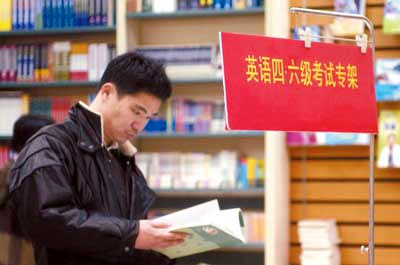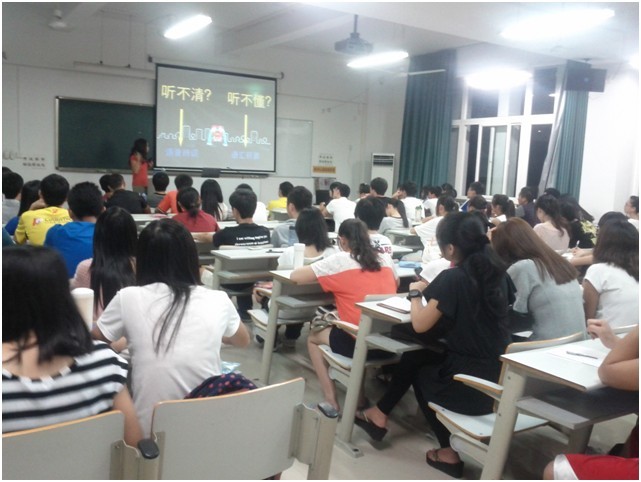 返回
教育头条
返回
教育头条

2018年英语四级听力题分享 大学英语
英语四级新闻听力
小编为提高同学的英语听力水平而申请的,每天推送一条四六级听力考试真题的音频。希望对大家的四六级考试有所帮助。
1.
A. An artificial art work sells for $432,500.
B. An AI-created art work sells for $432,500.
C. Portraits between the 14th and 20th centuries sell for $432,500.
D. A French portrait sell for $432,500.
2.
A. To collect characteristics from 15,000 portraits between the 14th and 20th centuries.
B. To search portraits from the internet.
C. To find differences between the human-made image and one created by the Generator.
D. To decide who should get credit for creating the painting.
1. What’s the news report mainly about
A. An artificial art work sells for $432,500.
B. An AI-created art work sells for $432,500.
C. Portraits between the 14th and 20th centuries sell for $432,500.
D. A French portrait sell for $432,500.
3. According to the news report, what’s the function of the tool called Discriminator
A. To collect characteristics from 15,000 portraits between the 14th and 20th centuries.
B. To search portraits from the internet.
C. To find differences between the human-made image and one created by the Generator.
D. To decide who should get credit for creating the painting.

A work of art created by artificial intelligence (AI) has been sold by a major art seller for the first time. The print sold for an unexpectedly(意外地) large amount of $432,500. Officials had predicted it would sell for between $7,000 and $10,000. The artwork was made by a machine learning algorithm(算法). The AI system was created by members of an art collective called Obvious in Paris, France. Three creators from the art group Obvious cooperated on the process that made the print. First, they put a collection of 15,000 portraits(肖像) into a machine learning system. The portraits were painted by artists from the time period between the 14th and 20th centuries. Then a tool called the "Generator" made a new image based on the information entered into the system. After that, another tool, called a "Discriminator," attempted(试图) to find differences between the human-made image and one created by the Generator. Obvious has created a series of AI-produced art works. The team has experimented with other kinds of historical paintings. These included subjects from nature to paintings of the whole human body. Artwork created by machine learning methods leaves open questions about who or what should get credit for creating the pieces.
小编为提高同学的英语听力水平而申请的,每天推送一条四六级听力考试真题的音频。希望对大家的四六级考试有所帮助。
1.
A. An artificial art work sells for $432,500.
B. An AI-created art work sells for $432,500.
C. Portraits between the 14th and 20th centuries sell for $432,500.
D. A French portrait sell for $432,500.
2.
A. To collect characteristics from 15,000 portraits between the 14th and 20th centuries.
B. To search portraits from the internet.
C. To find differences between the human-made image and one created by the Generator.
D. To decide who should get credit for creating the painting.
1. What’s the news report mainly about
A. An artificial art work sells for $432,500.
B. An AI-created art work sells for $432,500.
C. Portraits between the 14th and 20th centuries sell for $432,500.
D. A French portrait sell for $432,500.
3. According to the news report, what’s the function of the tool called Discriminator
A. To collect characteristics from 15,000 portraits between the 14th and 20th centuries.
B. To search portraits from the internet.
C. To find differences between the human-made image and one created by the Generator.
D. To decide who should get credit for creating the painting.

A work of art created by artificial intelligence (AI) has been sold by a major art seller for the first time. The print sold for an unexpectedly(意外地) large amount of $432,500. Officials had predicted it would sell for between $7,000 and $10,000. The artwork was made by a machine learning algorithm(算法). The AI system was created by members of an art collective called Obvious in Paris, France. Three creators from the art group Obvious cooperated on the process that made the print. First, they put a collection of 15,000 portraits(肖像) into a machine learning system. The portraits were painted by artists from the time period between the 14th and 20th centuries. Then a tool called the "Generator" made a new image based on the information entered into the system. After that, another tool, called a "Discriminator," attempted(试图) to find differences between the human-made image and one created by the Generator. Obvious has created a series of AI-produced art works. The team has experimented with other kinds of historical paintings. These included subjects from nature to paintings of the whole human body. Artwork created by machine learning methods leaves open questions about who or what should get credit for creating the pieces.
好了,就说这么多,希望对大家有用。我是你的学习顾问王敏,选课有问题,快来找行家,我会为你匹配最适的课程,欢迎大家关注我微信(18560125702),学姐近10年教培行业工作经验,从现在开始我就是你的私人顾问,为您的课程进行一个详细系统的讲解哦。返回教育宝头条
【免责声明】本文仅代表作者本人观点,与教育宝无关。教育宝对文中陈述、观点判断保持中立,不对所包含内容的准确性、可靠性或完整性提供任何保证。请读者仅作参考,特此声明!





